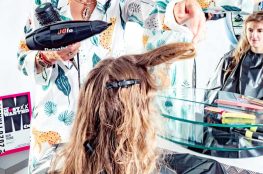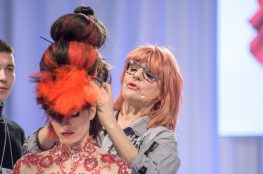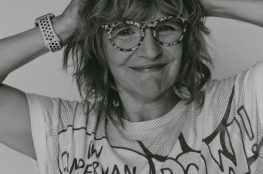Much like our skin, our hair changes over the years! And it is more than just going grey: hormone changes, lifestyle changes, can alter everything from lock thickness, to moisture, to brittleness…
‘Hair is not immune to the ageing process; just like the rest of our body, it changes as we get older,’ explains Anabel Kingsley, expert trichologist at Philip Kingsley.
So Anne wanted me to write little article inspired by Kris Jenner’s new subtle hairstyle, because trying something new has no age!
Has anyone else noticed Kris Jenner’s (the Momager) slight hair change? It seems small, but it is a big move away from her signature look, and we love a daring move!
Anne 100% believes it is so important to suggest a new hairstyle to her most regular clients! She does not want you guys getting bored, or thinking your stylist is taking you for granted and being lazy! We never want to hear you say “I have had the same hairdresser for years but I feel they never suggested anything new”…. So a thorough consultation is a must. We want to find out about your routine, help you find a style, and teach you how to best take care of it! We will be honest with the implications involved in whichever new style we go for, and if you want to learn how to dry and style it, just ask us to show you!
In the case of Kris Jenner’s new haircut, a shoulder-length bob with side-swept bangs at the front, Anne would have recommended the Relaxing Moisturising Fluid by Davines as it is perfect for creating a perfectly straight-haired look. This Relaxing Moisturizing Fluid adds shine, eliminates frizz, moisturises hair, and protects against heat damage and humidity. Combine with oil non oil also by Davines, a light oil for natural-looking and hydrated texture: this oil adds structure and definition to hair, smoothing frizz without leaving any residue (and is the winner of INSTYLE best beauty buy).
What age is hair at its best I hear you say? And we want to say there is no such thing! Big fat No to ageist hair dressing! However, our locks do change over the years, and here is how to best to take care of it no matter what decade you are straddling.
(taken from Prima.co.uk)
In your early to mid 20s
Your hair at this age: Strands very gradually get finer in diameter and are unable to grow as long as they once could.
How to look after it: The degree of change is in large part down to the genetic hand we are dealt, but it is also reliant on hormones, diet and general health, so try to eat well and look after yourself as much as possible!
In your late 20s to early 30s
Your hair at this age: This is the most common time for women to have children, and this can impact the hair. Six-to-12 weeks after giving birth, approximately 50% of women experience a type of hair shedding known as ‘post-partum hair fall’ – and this is in fact one of the most common hair concerns for women in their 30s. However, this can actually happen to a woman of any age who’s just had a baby.
How to look after it: While the overall thickness of the hair can drastically decrease, this hair loss is temporary; the shedding should stop and growth should resume as usual. Eating a healthy diet and managing stress levels can help the hair to recover as fast as possible.
In your mid 30s to early 40s
Your hair at this age: Ferritin (stored iron) deficiency is a common issue for women in their 30s and 40s – and remains common up until your periods stop at menopause. Ferritin is needed by the body to produce hair cell protein and a deficiency can cause excessive daily hair shedding, as well as loss of length – particularly around the temple areas.
How to look after it: To improve and maintain ferritin levels, try to eat red meat at least twice a week. Dietary supplements containing iron, vitamin C and vitamin B12 can also be very helpful, especially if ferritin levels are already below normal levels.
In your mid to late 40s
Your hair at this age: Volume reduction can occur at any age, but for the majority of women it usually becomes noticeable in their 40s. It is not that woman in this age group have fewer hairs in number than they used to, each hair is simply slightly finer.
How to look after it: To immediately improve the appearance of your hair’s thickness, try using a thickening spray when styling. You might also want to consider applying anti-androgenic scalp drops(try Tricho 7 Daily Scalp Drops) daily to help slow down the thinning of individual strands.
In your 50s
Your hair at this age: The average age of menopause is around 52. While subtle changes to the hair can and often do occur long before this, menopause speeds up these changes. As the body produces less oestrogen, and the percentage of androgens (male hormones) increase, the hair’s diameter and the length to which it will grow gradually decreases.
How to look after it: Again, daily application of stimulating anti-androgenic scalp drops can help to slow down the thinning of individual strands – and applying thickening sprays throughout the length of the hair can give the appearance of more body.
Finer hairs are also weaker, so it is important to take extra care when styling so as not to snap strands. Choose a brush that is gentle – the best are cushioned at the base with rounded, plastic prongs.
In your 60s+
Your hair at this age: Sebum (oil) secretion tends to diminish in our 60s and 70s+, and this can make the hair dry and brittle. Our haemoglobin levels also tend to decrease during at this time of life, and this can affect hair health.
How to look after it: To restore moisture, strength and elasticity, use a weekly intensive pre-shampoo conditioning treatment. To improve haemoglobin levels by taking a daily supplement containing Iron and Vitamin C.
Have a fabulous hair day!
xxxDFG
www.dirtyfrenchgirl.com




